Matador Network's Blog, page 2274
May 1, 2014
Watch these Saudi daredevils go nuts
There are some completely insane stunt videos that the internet spews forth that you watch and think, “That was one misstep away from being a snuff film.” This is one of those videos. This group of Saudi thrill-seekers I guess decided that changing a car’s tires while stopped was for noobs and wusses, so, while driving, they managed to get the car up on two wheels (like James Bond through a narrow alley) for long enough to remove two of the tires and put them back on.
I’d say “don’t try this at home,” but, honestly, if you’re skilled enough to pull it off, kudos, and if you’re dumb enough to try it, maybe the gene pool doesn’t need you around all that much. 
The post How to change your car’s tires…while the car’s still moving appeared first on Matador Network.

14 people you meet on a road trip

Photo: Karl-Ludwig
1. Cab driver in Austin, Texas
He’s still on the phone when he picks you up at the airport, coughing and sniffling into a white handkerchief. You sit silently in the back of his rust-speckled van. Your seat is covered in a faded quilt. You can feel that it’s damp. He puts his hand over the receiver and tells you that he has allergies; it’s not the flu. He drops you in front of a seedy motel off the highway. It’s 11 o’ clock at night.
2. The Avis rental salesman
He welcomes you, comments on the sunny morning, and points to your rental in the parking lot behind him. The keys are on the counter. You hand him your debit card. Three hesitant swipes later he tells you that there is “something” in your credit. You won’t be able to rent a car today. He won’t take cash.
3. The man with the truck
Eric is selling his late father’s 1996 Ford F150 on craigslist. It has a cattle-pusher and a headache rack. There are 128,000 miles on the odometer. He drives the hour from San Antonio to meet you and leaves 45 minutes later in his girlfriend’s Pontiac.
4. The mechanic
You take the truck to a shop a couple blocks away. The mechanic is a toe-headed cartoon of a character with long, thinning hair. He slaps you on the back and says that you made a good choice. He loves F150s. Those girls won’t die.
5. The 24-hour waiter
The truck’s at the shop, so you sit down at a 24-hour, 7-days-a-week, 365-days-a-year diner. The Star Seeds Cafe. You order huevos rancheros and your waiter tells you to linger as long as you like, he doesn’t feel like waiting tables today.
6. The elderly lady in the restroom
You’re washing your face in a rural gas station bathroom five hours later. The walls are plastered in Marilyn Monroe paint-by-numbers. An elderly lady shuffles out of the stall. She’s wearing white linen gaucho pants and those boxy side-windowed sunglasses. She greets you as if you just showed up on her doorstep. With an “Oh, Hello! It sure is a beautiful day to travel, isn’t it?”
“It really is,” you say.
7. The Bengal tiger at the gas station
You stop on the Louisiana line to fill up. There’s a cage out by the road. There are signs staked in the ground that read, “Save Tony! Tell Legislators that he belongs here!” You walk over and find 500-pound Tony sleeping on top of a box. A trucker in a John Deere hat stands next to you and yells “hey!” three times. “Hey! Hey! Hey!” before shaking his head and giving up. Tony lies there in the afternoon sun with his eyes open.
8. The gutter punk in the French Quarter
He looks like a rejected Mad Max extra with tribal tattoos inked on his forehead. He’s squatting on the sidewalk and sipping on a bottle of Magic Hat #9. There’s a tin cup on his belt loop and a purebred Great Dane by his feet. A tortured Urban Outfitters model pouts beside him. First he asks you for a dollar. No. Second he wants your sandwich. No. Third he wants to sell some weed. No thank you. Fourth he wants to fight. “Look at me, I’m poor!” he yells at you.
Are you really? You think.
9. The guy writing the novel
You walk into Molly’s and have a vodka on the rocks. It’s standing room only on a Friday night. There’s a man in the back writing in a black moleskin journal. He tells you he’s writing a novel. Without prompt he launches into a discourse on metaphysical selfhood, pausing only to reflect on what he just said. He tells you he’s also a carpenter. His hands on the table are as lily-white clean as the cotton v-neck he’s wearing. You leave feeling exhausted.
10. The neighborhood kid
There’s a 10-year-old kid that comes and sits down next to you in your friend’s garage. He tells you five yo-mama jokes in a row. You haven’t heard any of them. His gestures are as huge and confident as a businessman on the weekend. Each joke is dirtier than the last. Before he leaves he gives you a list of his favorite YouTube videos.
11. The Mississippi State Trooper
He pulls you over to give you a friendly warning. Don’t drive too close to the 18-wheelers, he says. You give him your Maine license and a Texas title. He doesn’t understand what you’re doing in Mississippi.
Eric who sold you the truck is Eric Garcia. The trooper doesn’t like that last name. He wants to know how many times you’ve crossed US-Mexican borders. He wants to know what drugs you have in the truck.
An hour later he finds nothing and you get the fuck out of Mississippi.
12. The kid at the Nashville dive
You walk into Bobby’s Idol Hour around noon on a Saturday. There’s a group of men chain smoking and playing guitar in the corner. He can’t be much older than you. He says that he wrote this next song while he was homeless in Philadelphia. It’s about Columbine. You blink back tears and finish your Corona.
13. Bernie
You go to the Wheels Through Time Museum in Maggie Valley, North Carolina. You want to see all the motorcycles. Bernie is a little elderly man with two hearing aids. He leads you around the museum, holding your hand and patting it as he happily tells you the back-story of every vintage bike. You impulsively buy a $50 raffle ticket to win two custom-built Harleys.
14. Mike from the Asheville open-mic
He’s a longhaired, white-haired, smiley-faced North Carolina man. He plays a steel-bodied guitar with a slide and he sings about his buck-toothed Clementine. You see him loading into an old beater black van that you keep seeing around town. He yells, “I’m driving this thing all the way to Belfast, Maine!” He’s never been to Maine, he says. “Oh, you’ve gotta go,” you say.
The next morning you get up, happy to head that same way. 
The post 14 people you meet on a road trip appeared first on Matador Network.

How NOT to forget a language

Photo: Bob Prosser
Forgotten languages, and understanding why
In my travels and lifestyle, the reason I learn a language is simple: to immediately use it with locals and enhance my cultural experiences. This is not quite the same as many people, who choose their one language to learn based on a long-term investment. A polyglot has many languages to deal with, and this changes things significantly compared to someone with a one-language priority.
What this means is at the end of my two- to three-month projects to intensively learn a language for an upcoming trip, I face a crossroad: Should I maintain this language or not? Some people may take a “not” choice completely out of context and feel like the whole experience was worthless.
Every language I have learned has enhanced my travels in ways I can’t begin to express. Saying that any one of them was a waste of time ignores the cultural experience that was my priority all along. I’m not passionate about languages, I’m passionate about using them.
Maintaining them as described below is so much work that if that passion doesn’t spark a lifelong interest in the language, then I simply will not prioritise it — as a polyglot, I have quite a lot of languages to juggle! This is obviously not the same situation for someone who has learned one foreign language over an extended period of study.
A consequence of this is that as much experience as I have in learning and speaking languages — seven of which I can now say I speak fluently — I have plenty of experience too in forgetting languages.
I have learned Hungarian, Czech, Catalan, and Tagalog and could converse and socialise in all of them at various levels. But now I can’t. Nowadays, I’d never even list them as languages I can get by in to be honest. But I don’t apologise for this or lose sleep over it. I knew it was going to happen.
So what did I do differently with my successfully maintained seven languages compared to those listed above?
Consistent practice
The “secret” (no surprise) is simply consistently using the language so it is always fresh in your mind.
Of course you can come up with lazy excuses why this is not possible, but the truth is you can always find ways to use those languages. Find natives to meet in person via social networks, use certain sites to find people to talk to by Skype, be friendlier with tourists, join clubs and actively monitor your social circle and environment for opportunities to use the language. All of these are ways you can speak your language immediately.
To maintain other aspects (reading, writing, listening, etc.), the best way is by doing them. Listen to podcasts in the target language, read blogs or online news or an entire book in that language, keep in touch with your foreign friends by chatting to them on Facebook or writing them emails; but do this every day.
The language will deteriorate in your mind if you don’t keep it active. Having learned it “once” does not mean you now own it forever; use it or lose it!
Speed of learning
As far as I can tell, there’s only one major disadvantage to my rapid learning strategy: The quicker you learn it, the quicker you’ll forget it. This may sound bad, but it’s way better than the alternative of learning so slowly you have nothing to show for it, ever.
If you dive intensively into your language learning project, and reach high conversational level or fluency after a few months, you have to be sure you’re consistently maintaining it until it is a permanent part of you. I found with the languages listed above that within just a few months, I lost the vast majority of my ability to communicate in them — I forgot as quickly as I learned.
So if you learned your language over years (actually using it, not simply being present in a classroom for something that could only laughably be called “years”), you’ll be much less likely to forget it as quickly. Spanish is the language I’ve put the most time into, for example, and I’m confident that I could cut myself off from the language entirely for a year and get back into it no problem. I’ve spoken and lived through Spanish so much that it’s burned into me.
But the point is I wouldn’t cut myself off from Spanish. Why would I do that? If you genuinely want to speak a language for life, it will always be there for you to use. Even with seven or more languages competing for time with me, I will always give the important ones the time they deserve (what makes a language important depends on you, not some economic, etc., criteria or what someone else says).
Even though I’m certainly aware of the danger of forgetting a language quicker due to learning it quicker, I still think this hardly counts as a “disadvantage.” You’ll only forget it if you aren’t using it. This is true whether you learned it quickly or slowly, only the speed of deterioration is different. After I had learned the other languages on my list quickly and intensively, I kept up the good work of consistently using them and will never forget them because of that.
Passion and the why
The main reason I’ll never forget my current languages and certain future ones I take on, while I will forget others, is because I’m passionate about the former beyond a fixed point in time when they served the purpose of cultural immersion. That one thing, the why that sparked a flame inside me during my experience in the country, means I will never let it go.
If you don’t want to ever forget a given language, don’t ever let it go. Make it an important part of your life; reading books and keeping in touch with friends is never a chore, but something that would leave a huge hole in your life if taken away. 
This article originally appeared on Fluent in 3 Months and is reprinted here with permission.
The post Forgetting a language: Why it happens and how to avoid it appeared first on Matador Network.

4 minutes of Singita in South Africa [vid]
Watch in HD!
In the fall of 2013, Matador traveled to Southern Africa to rock out in Cape Town, road trip through Namibia, and learn more about the most successful safari brand in all of Sub-Saharan Africa, Singita.
We visited the Singita resorts in Sabi Sands and Kruger National Parks. This is our experience across both parks, crammed into less than 4 minutes. 
Video by Scott Sporleder, words by Ross Borden — both were generously hosted by Singita on this trip.
The post 4 minutes of Singita in South Africa [vid] appeared first on Matador Network.

37 crazy pictures of storms
It’s finally spring on the East Coast of the United States. Sort of. If you don’t count the occasional two-day relapse back into winter. Either way, we’re in storm season: For the rest of the year, we can expect crazy shit like hurricanes, tornadoes, thunderstorms, hailstorms, and just general windiness.
Since it’s probably going to bury our town or city under four feet of water and maybe destroy our roof shingling, we might as well get as much enjoyment out of it as we can. Fortunately for us, storms are some of the most beautiful natural phenomena on the planet, so there’s plenty of stormy visual awesomeness that’s been captured for us on camera. 
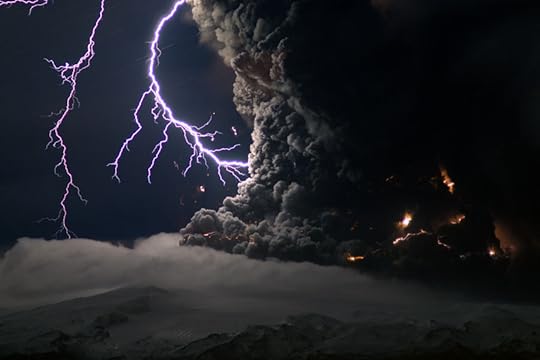
1
Volcano lightning
Yes, this is a real thing. Volcano lightning, or “dirty thunderstorms,” occur when volcanic ash, ice particles, and rocks collide in a volcanic plume, causing static and, eventually, lightning. This photo was taken during the 2010 eruption of the Icelandic volcano Eyjafjallajökull.
(via)

2
Haboob in Phoenix
“Haboobs” are massive dust storms. This one famously hit Phoenix in 2011.
(via)

3
Thunderhead in Silver City, New Mexico
This is definitely just a cloud. I’m like, 98% sure it’s not the second coming.
(via)

See more like this: 60 insane cloud formations from around the world
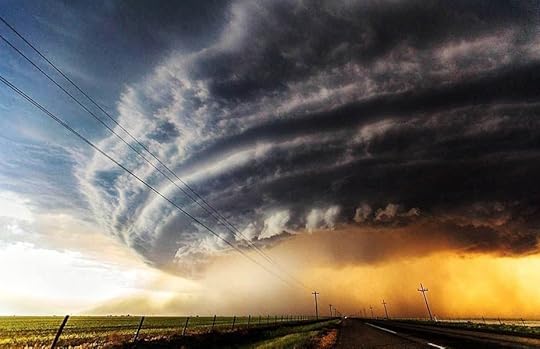
4
Storm in Tornado Alley
This photo was taken by a stormchaser photographer as part of a series set in the USA’s infamous Tornado Alley.
(via)

5
Lightning in Zirje, Slovenia
Most stormchasers, contrary to what Bill Paxton and the movie Twister would have you believe, are usually not in it for any scientific gain. The hobby is generally geared towards thrill seeking and photography.
(via)

6
Mammatus clouds
Mammatus clouds are usually found at the base of a anvil cloud, and are a sign of oncoming massive thunderstorms. They’re also apocalyptically cool looking.
(via)
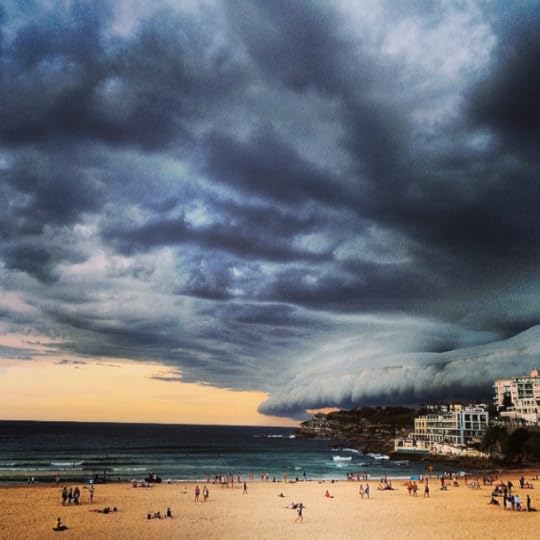
7
Storm over Sydney, Australia
This photo was one of many taken during a storm that rolled in over Sydney back in March.
(via)
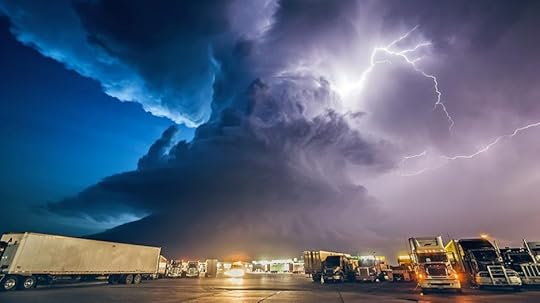
8
Supercell in York, Nebraska
This massive supercell was captured on film in 2009 by professional stormchaser Mike Hollingshead.
(via)

9
Supercell in Sioux City, Nebraska
This supercell happened in May of 2004.
(via)
Intermission
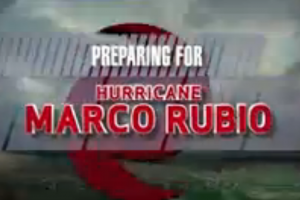
Let’s start naming storms in a way that makes sense, after policymakers who deny climate change
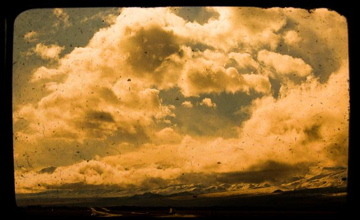
Notes on Storm Traveling
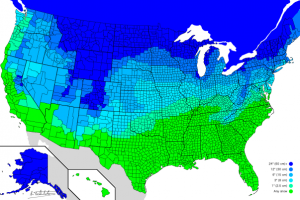
This map shows how much snow it takes to cancel school where you live

10
Oncoming storm in Cape Cod, Massachusetts
If you see this, go inside.
(via)

11
Lightning over Chicago
The old saying “lightning never strikes the same place twice” is obviously untrue. Most skyscrapers are hit with relative frequency. The Empire State Building (not pictured here, this is the Willis Tower) is hit an average of 25 times a year.
(via)

12
Tornado in Burdett, Kansas
Tornadoes are only considered tornadoes if they are in contact with both the cloud and the ground. Until they touch down, they can be considered cyclones or funnel clouds.
(via)
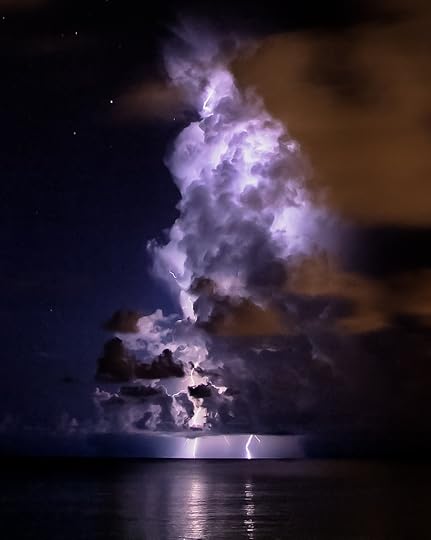
13
Storm near Grand Cayman Island
For most lightning photos, long exposures are required.
(via)
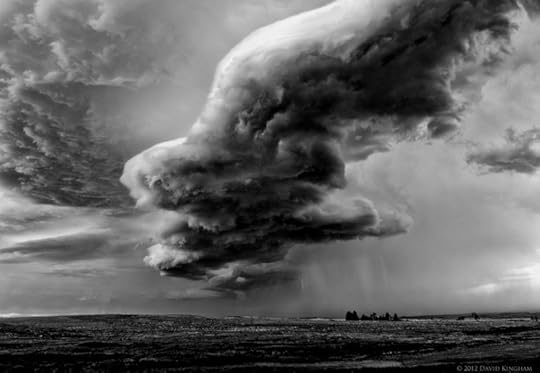
14
Storm over South Dakota
“Tornado Alley” in the United States, which also sees the most supercells and severe storms, is actually a pretty wide alley. It covers most of the land between the Rockies and the Appalachian Mountains.
(via)

15
Taken from a plane en route to Denver
Airplanes offer some really excellent views of storms as well, if you can get the right angle and not much glare.
(via)
Intermission
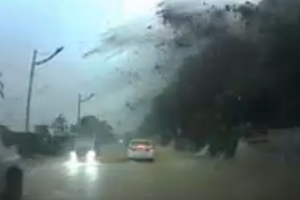
Taiwanese dashboard cam captures car almost getting annihilated by landslide
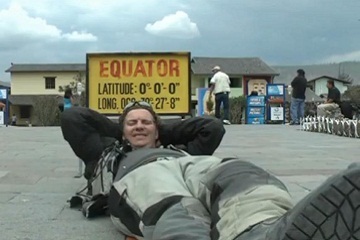
Colombia to Ecuador on motorcycle

60 insane cloud formations from around the world [PICs]

16
Storm near Crete, Greece
The beach is the best place to watch a storm, usually because you can see it coming from far enough off to enjoy it.
(via)

17
Rainstorm in the mountains
Rainstorms are another difficult storm to capture on camera, usually due to the low visibility inherent in the storm.
(via)
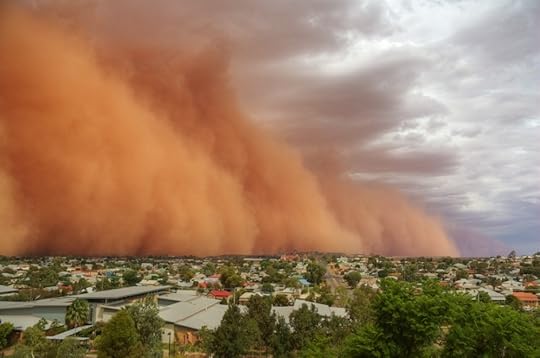
18
Haboob in New South Wales, Australia
This shot of a haboob was taken in Broken Hill, New South Wales, back in 2010.
(via)
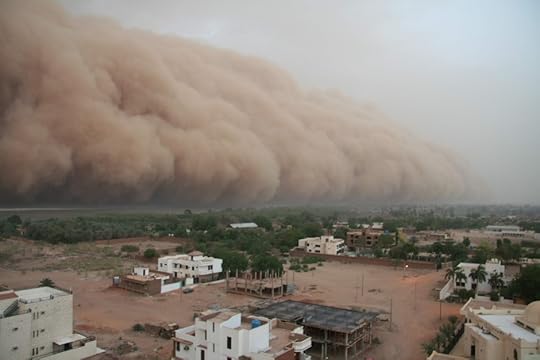
19
Haboob in Khartoum, Sudan
While the Phoenix haboob got way more press in the United States, haboobs are the most common in arid regions like the Sahara.
(via)

20
Tornado in Oklahoma
Tornadoes (like this one in Anadarko, Oklahoma), are usually around 250 feet across, but the truly massive ones can be as much as two miles across.
(via)

21
Tornado debris in Lennox Head, Australia
The debris of the tornado is in part what makes it so dangerous (you know, aside from the 300-mile-an-hour winds).
(via)
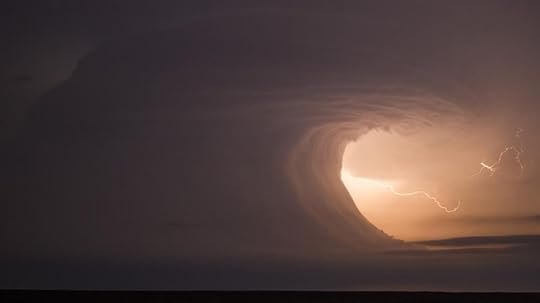
22
Supercell in McCook, Nebraska
My source says this is a supercell, but I’m pretty sure it’s the Biblical rapture or something equally apocalyptic.
(via)

23
Lightning over the Gulf of Izmir
The Gulf of Izmir is in Western Turkey, along the Aegean Sea.
(via)

24
Hurricane Sandy
Hurricanes are probably the most difficult storms to photograph the sheer magnitude of, just because they don’t fit into a neat, relatively small cloud formation like a tornado. But this photo taken by NASA satellites showed just how massive “Superstorm” Sandy was, and helps explain how it devastated so much of the East Coast.
(via)

25
Haboob in Phoenix
This is another image of the Phoenix haboob, taken from an airplane.
(via)

26
“Mothership” over Childress, Texas
This storm is called a “supercell,” which refers to thunderstorms with a rotating updraft. They are by far the most severe (and mercifully, the most rare) type of thunderstorm.
(via)

27
Wall clouds in South Dakota
Wall clouds are usually the bottom portions of cumulonimbus thunderstorms, and are the basis for most tornados.
(via)
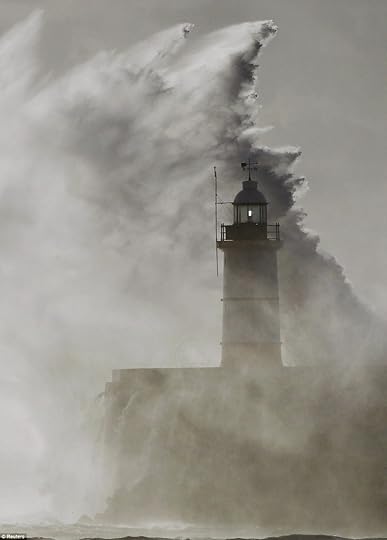
28
St. Jude storm in the UK
A massive storm battered the southern United Kingdom back in October of 2013.
(via)

29
Lightning storm in the Grand Canyon
This picture was taken using a 25-second shutter speed in the Grand Canyon by photographer Rolf Maeder.
(via)

30
Cloud formation in Beverley, England
It’s difficult to be sure this was an oncoming storm. It’s definitely a cumulonimbus, and it very much could be a massive storm. It’s too cool a picture to leave out, though.
(via)

31
Waterspout in the Balearic Islands of Spain
Waterspouts are basically tornadoes that only touch down on the water. While they are still super dangerous and you should not go near them in a boat, they are much safer than tornados on land because of the lack of debris.
(via)

32
Oncoming storm in North Dakota
This is technically called a shelf cloud, but I prefer to think of it as, “Holy shit, the UFOs from Independence Day are here.”
( via)

33
Storm in Norman, Oklahoma
These clouds are the same as the mammatus clouds mentioned earlier. Also, let’s enjoy for a moment the phrase “Storm in Norman.”
(via)

34
Oncoming storm in Miami
Kudos to the ballsy sumbitch who was airborne during the taking of this photo, even in the face of the oncoming storm.
(via)

35
Storm in Kansas
Kansas gets shit on (unfairly) for its flat, less exciting landscape. But that landscape does lend itself to gigantic, awesome, beautiful storms.
(via)

36
Lightning over Munich
Though significantly more massive than when you brush your feet against a wool carpet, lightning is technically the same thing as a normal static shock.
(via)

37
Pre-storm clouds in Hong Kong
Storms as seen over skylines are probably my favorite, as they always dwarf the city.
(via)
The post 37 crazy pictures of storms from around the world appeared first on Matador Network.

April 30, 2014
On the realities of expat life in Ghana

Photo: Retlaw Snellac
I’m having one of those days — actually no, one of those weeks. A Ghana week.
Now for most Ghanaians, a Ghana week is just that: a week in Ghana. But in our expat family, a Ghana day (or week!) is synonymous with frustrations up to your eyeballs. All the shine has gone off, it’s not exotic, or adventurous, or fun. It’s routine, it’s hot, it’s boring. You just feel worn down, pissed off, too tired for anger, and frustration simmers constantly.
It starts simply enough, one or two little problems. But then maybe these problems don’t go away. You make phone calls, again and again, but nothing happens. And then maybe the fridge breaks, and you watch it, sitting innocently outside your front door, waiting, waiting…waiting for it to be picked up. In the meantime, the washing machine decides it’s lonely, and joins the fridge. And then something you were promised weeks ago finally arrives, bearing no resemblance to what you were promised. And then something else arrives, and it bears no resemblance to what you were promised. And there are more phone calls, the usual excuses (phone problems, traffic problems, problems, problems, problems), all couched in polite voices.
And I sit in the traffic seething. I shuttle the kids backwards and forwards, watching sport and or some other activity, and my mind is elsewhere. Quite often it’s in Greece, but more often, it’s just absent. MIA.
And then something happens at home. The home that you are 15,000km away from. And all the frustrations you are pushing down with a barge pole boil over, and you feel not only frustrated but pretty helpless as well. There are Skype calls and emails. But all this amazing technology makes you feel more helpless, more frustrated, and you (secretly, foolishly) wish for simpler days. Days before the internet, when months after the fact you would have found out the news. Deep in your heart, you know this isn’t really what you wish for, but you also know even if you were there, there is actually very little you could do.
Do you know the expression, “The lights are on but no one is home”? Well, today, the generator is on, but there’s no power at home. It seems the generator has gone out in sympathy with the fridge and the washing machine. I’m sitting on the veranda trying to catch a few breaths of equatorial breeze. Just sitting and sweating. No power means no water, no water means no shower. I can’t open the fridge (small, bar-sized replacement), for fear of letting any of the precious cold air out. I squint into the midday glare and watch the traffic inch past, counting down the minutes till I join them. I just saw the Emirates jet take off and was filled with childish longing.
Years ago, a particularly melancholic friend told me, “Depression is anger without enthusiasm.” And maybe these Ghana days are like that too…frustration, without enthusiasm. But I also know it’s about expectations. I’m suffering from a big, bad case of First World Problems. We have more than enough food, enough money, good health; we are living extraordinarily privileged lives. I need to get out, do some exercise, see some new sights, break out of the bubble we live in and remind myself why we came here (why was that again?).
I need to lift the veil and look again with fresh eyes. I need to be thankful for all that we have, and forget what we don’t.
To snap out of this funk I went for a walk. This walk wasn’t about reconnecting with nature, it was about reconnecting with my life. I walked up one of the main roads of Accra, past the streams of traffic, through the heat and the noise. I watched the toilet paper get delivered to the roadside vendors. I saw tiny shanty houses one block from our home. I saw beautiful young girls selling sachet water on the side of the road, their education finished at 13.
I know it is just the dumb luck of life that they are not my girls.
It’s time to quit sulking.
It’s time to be grateful. 
This article originally appeared on Six Degrees North and is reprinted here with permission.
The post On the realities of expat life in Ghana appeared first on Matador Network.

Crazy POV avalanche video
I swear, every time I open my web browser there’s a new insane GoPro video. This one was taken by Canadian freeskiier Eric Hjorleifson, who attempted to ski a big mountain pillow line, set off an avalanche, and then had to ski through it.
Skiing through an avalanche is not a thing you can do, really, but Hjorleifson is okay. You can best see the avalanche starting at about the 0:22 second mark, and then see how terrifying it’d be to see an avalanche and realize you have no choice but to ski through it. 
The post What it’s like to cause an avalanche…and then ski through it appeared first on Matador Network.

10 signs you're from Ireland

Photo: Arileu
1. You know all the words to the Home and Away opening theme.
Whether you watched the show or not is irrelevant, because when push comes to shove you can recite this catchy number word for word. Before your mate leaves for Oz, all the gang will be belting this one out at the top of their lungs down at the local boozer. CLOSER EACH DAY, HOME AND AWAY!
2. You’ll do almost anything “for the craic.”
Let’s begin this with a translation: “Craic” is our way of saying “fun!” You’re teetering towards staying off the beer for the night. Tomorrow’s a busy day at work and you have the sense to know the only consequence of a night of drinking is an almighty hangover the next day.
Shame your pals know you have the willpower of a fat kid giving up chocolate for lent. “Sure, go on, for the craic!” they say. Ten pints, two sloppy kebabs, and a night of debauchery later, you lie staring at your alarm clock wondering how you got home but knowing deep down that the craic must have been mighty.
3. You know the importance of tea.
Tea holds a distinct place at the heart of Irish culture. Don’t be confused with the recent surge of coffeeshops opening their doors — Ireland is a tea-drinking nation. Generations past and present have marvelled at the power of the beverage, finding it impossible to reject the offering of a cup. Citizens take ample pride in their tea-making abilities and have been known to judge others based solely on this skill. Some folks will pour their heart and soul out over a warm cup of tea, so pop the kettle on and let the banter flow.
4. You love to complain but never act on it.
Our general outlook on life is non-confrontational. We hate to be seen as the odd one out, or worse, be known as a moaner. So the steak you ordered medium rare came out well done. Why put the server through all the hassle of bringing it back to the kitchen and having the chef cook another one, when you can look at this as a perfect opportunity to see if your teeth are still in good-working order?
That Mohawk you wanted at the barber? Buzz cuts are in fashion and you were spending too much money on hair gel anyway. While approaching the cashier you briefly contemplate asking for the manager, but as the hairdresser asks if everything is okay, you force a smile and muster, “Ah yeah, it’s grand!”
5. You know the pain of The Wooden Spoon.
Children on television were disciplined by being sent to their room for the evening and eventually got a heartwarming speech on what they did wrong in the first place to warrant a punishment. How adorable! In Ireland the penalty for getting in trouble was receiving a few smacks of The Wooden Spoon somewhere on the leg/arse/“whatever they hit will do” area.
“Do you want me to get The Wooden Spoon?” was not a threat you took lightly and knew to toe the line there and then. It’s been 20 years since your last smack, yet you still avoid using the utensil while cooking for fear of some painful memories resurfacing.
6. Several of your childhood heroes were puppets.
Before the advent of satellite television, the youth of the land had two stations to choose from, with twin aliens, sock monsters, and talking turkeys ruling the roost (pardon the pun). From the ages of 6-10, you were the coolest kid in school for the day if Dustin the Turkey gave you a birthday shoutout. There was something about a foul-mouthed turkey with a north-Dublin accent that resonated with young viewers as he went on to release several albums (admit it — you bought at least one!) and in 2008 represented the country in the Eurovision Song Contest.
7. You show incredible loyalty to certain brands.
You eat King or Tayto crisps, drink Barry’s or Lyons tea. God forbid you should like two competing brands. You react with scorn when a friend informs you of their allegiance to the other one.
8. You watch the Father Ted Christmas special every year.
No Christmas is complete without watching Ted and Dougal get lost in Ireland’s largest lingerie section. It doesn’t matter that you’ve seen it a gazillion times, throwing out a quote from this at the pub is a sure way to get a few laughs. Watching it again won’t hurt, and the chuckles you score could be the closest you ever come to feeling like a standup comedian.
9. Socks and underwear are token gifts from your parents.
An Irish mother’s way of saying she loves you.
10. You can’t dance.
International opinion of Ireland would be that we have all been on tour with Riverdance. Oh, if only they knew! Realistically, the entire population could easily be extras on Jersey Shore. The average Irish person’s arsenal of dance moves is limited to fist pumping and flailing their hands in random directions to the point they feel others are staring. Movement from the torso down is kept to a bare minimum. The last thing you want to happen in a nightclub is be forced out on the dance floor, so just hold that pint close to your chest and laugh at everyone else making an effort. 
The post 10 signs you were born and raised in Ireland appeared first on Matador Network.

26 images of Costa Rica conservation
YOU WOULDN’T THINK IT COULD GET any better than that: standing on a hanging bridge at sunset, high over the cloud forest of Costa Rica, muscles pulsing from an adventure-filled day.
Then the fog starts rolling in. A very thick fog. So dense you can’t see the end of the bridge you’re standing on. The fog is cascading through the treetops, you lose your sense of depth, the over-saturated green slowly fading to grey. Everything is muted.
And then the breeze starts blowing in your hair, the mist clears and uncovers one of the most epic sunsets you have ever seen. That was when I fell in love with Costa Rica. But what was even more comforting after such a powerful moment was to know that this place — the Monteverde Cloud Forest — along with many other reserves across the country, will be protected for decades to come. 
This post is produced in partnership with Contiki, the world leaders in youth travel. In early April, Matador Ambassador Alex Strohl participated in a Contiki Cares conservation trip through Costa Rica.

1
On the day we arrived in San Jose, I met up with local photographer Miguel Vargas. He drove us up to the highlands near the capital city for one of the best sunsets I've ever witnessed.

2
Everything for the shot. This is YouTube sensation Mr. Ben Brown hiding behind a huge banana leaf in a Dole banana plantation. Scoring this image involved getting half covered in mud and attacked by ants, but it was all worth it.

3
Connecting with the local fauna in Costa Rica. This is a rhinoceros beetle.

See more: 35 images of Costa Rica we can't stop looking at

4
Marine biologist Emma Harrison at the Sea Turtle Conservancy in Tortuguero National Park. Meeting this person was fascinating in every aspect. I always admire someone who dedicates their lifetime to one single mission.

5
Vancouverite Mirae Campbell, one of the winners of the Storytellers: Costa Rica contest, venturing into the tropical forest, barefoot.
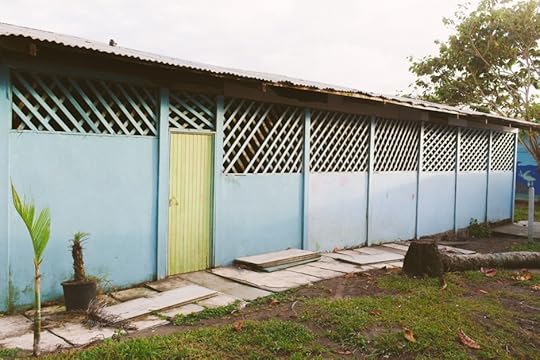
6
The elementary school of Tortuguero was painted in some very photogenic hues.

7
We had an interesting conversation about life in the small town of Tortuguero with local Roberto.

8
I noticed this tattoo on the foot of Eline Postma, another contest winner, on our way to the Sea Turtle Conservancy.

9
This is Celine Cousteau, granddaughter of famous explorer and conservationist Jacques Cousteau. Meeting her was one of the highlights of the trip. Celine's devotion to positive storytelling and the preservation of the planet really put everything in perspective.
Intermission

Photo Contest: When travel goes WRONG

Photo essay: Chilean educational protests continue
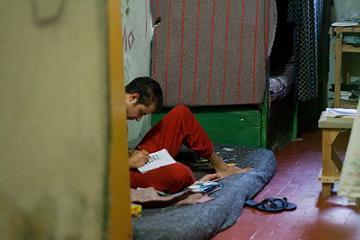
Photo Essay: Going Inside Brazil’s Prisons

10
Visiting a cacao plantation. These are freshly picked cacao beans, the main ingredient in chocolate.

11
Taking it all in at La Fortuna Waterfall. I could have stayed for days.

12
One of the cutest couples of the school in La Fortuna, sharing some laughs after their dance performance.

13
Visiting the backstreets of the quiet village of La Fortuna.

14
In the distance you can see the Arenal volcano. Visitors used to be able to hike to the top of it, but after many tragic accidents the summit has been closed.

15
Cooking lessons, Costa Rican style.
Intermission

Photo Essay: Exploring Morocco’s Pink City and Beyond

Photo essay: Dia de los Muertos in Oaxaca, Mexico

Photo essay: Light and shadow in Chiang Mai, Thailand

16
A misty morning boat ride across Lake Arenal.

17
Driving the narrow roads of the highlands was such a great experience. Spending time in such remote locations just makes you want to move here and become a farmer.

18
These wooden bridges where built for an American movie and left behind for visitors in the Monteverde Cloud Forest to see.

19
The finish line of one of the longest zip-lines of Central America. It's a little over 1.2 miles (2km) and offers some of the greatest views over the cloud forest.

20
I fell in love with the hanging bridges of Costa Rica.

21
Travel writer Sara Duff scouting for fog.

22
The Monteverde highlands seemed to be constantly bathed in the softest fog.

23
I have never witnessed so many wildlife sightings in such a short period of time. Thanks to the dedicated conservation programs Costa Rica is running, the fauna enjoy a nurturing natural habitat.

24
One of the many stunning beaches of Manuel Antonio National Park. Arriving at the Pacific meant two things for us: One, we could finally swim in the ocean. And two, sadly, our Contiki adventure was coming to an end.

25
Another thing I will never forget about this trip was seeing monkeys in the wild.

26
The #ContikiStoryTellers crew enjoying their last swim before getting back to reality...and definitely taking inspiration from the trip home with us.
The post 26 inspiring moments from a conservation trip through Costa Rica appeared first on Matador Network.

How to be a successful Airbnb host

Photo: kris krüg
Surprise your guests.
Little surprises, like sharing homemade treats or a welcome bottle of wine upon the guest’s arrival, can make an extra strong impression and turn a comfortable stay into a memorable one. Get creative and do something unique. One of my favorite stays was with a talented cook who gave us daily helpings of homemade dried fruit candies (which were amazing and addictive) that she made every day during our stay.
Keep it clean and tidy.
Give a lot of attention to cleaning every square inch of your space. Guests want to feel relaxed and at home. They don’t want to worry if where they’re sitting or what they’re handling is covered in nastiness. It’s easy to tell when it’s not. A clean space smells fresh, looks crisp, and just feels right:
Clean the floors. Finding other people’s hair lying around is a huge turnoff.
Dust the shelves and any flat surfaces (and the knickknacks on the shelves, the magazines on the coffee table, the items on the kitchen counters, etc.).
Clean the TV remote and any other items guests normally touch, including light switches and the fridge and freezer door handles.
If you have blankets out for cozying up on the sofa, make sure they’re the washable kind. Think about how gross sharing an unwashed blanket (or sofa pillow) with 50 strangers would be.
Use a slipcover on furniture, and wash it between every few guests. I stayed in one Airbnb property owned by a bachelor who’d obviously been sitting on his sofa naked and sweaty for years. It smelled so bad of manly body odor I couldn’t handle being anywhere near it.
The kitchen should be spotless. Nobody wants to cook in a pan caked in somebody’s old grease. For longer stays, provide the guests with a brand new sponge so they can happily wash their dishes.
Cleaning bed linens and bath towels and kitchen towels goes without saying, right?
Note: Airbnb is currently testing out a new cleaning service that could make this incredibly important factor much easier.
Be friendly.
When you treat your guests with warmth, positivity, calm, and in-control energy, like they are potential new friends instead of just a business transaction, everyone will be much happier. When unfortunate events occur, as they will, your genuine friendliness (along with immediately taking care of any problems) will help smooth things over.
Respect your guests’ privacy.
You want to be friendly, but not too friendly! Giving people their space and leaving them alone to do their own thing is most often the best idea. You can gauge whether your guests are interested in interacting with you by casually offering (sharing a meal together or giving them a tour of your city, for example) but leaving it very open for them to decline and do their own thing.
Offer bicycles to rent or borrow.
When you’re not close to easy public transportation, providing bicycles that are in good working condition can be a huge perk of a good Airbnb stay.
When I was in Cambodia exploring the temples of Angkor Wat, the old and worn back tire on my bike exploded and I was stranded miles away from help. Fortunately, after an hour of walking, I got a ride in a tuk-tuk willing to precariously pile me, my girlfriend, and our two bikes inside. When we reached our Airbnb property, our hosts immediately fixed the tire and I was able keep exploring for the rest of the stay.
Provide local information, maps, guides.
The most professional hosts create guidebooks that contain information about the local area, including genuine and personal recommendations for their favorite restaurants, activities, and sights.
Decorate with style, but not too much style.
Putting your personal style on display is a great way to create a memorable and unique space. But too many personal items strewn everywhere can make a guest feel awkward, like they’re intruding in your space. Get rid of clutter and give your guests places to put their own things.
Respond ASAP to communication from your guests.
Your guests will run into issues at some point. It’s your job to respond right away to fix any problems or answer any questions they have. It might be appropriate to give them access to your phone number. Some hosts in foreign countries will even provide a cell phone for guests to use that makes contacting them incredibly easy. If email or Airbnb messaging is your preferred way of communicating, make sure you set up your email to notify you immediately of messages they send. 
This article originally appeared on Medium and is republished here with permission.
The post How to be a successful, highly rated Airbnb host appeared first on Matador Network.

Matador Network's Blog
- Matador Network's profile
- 6 followers



